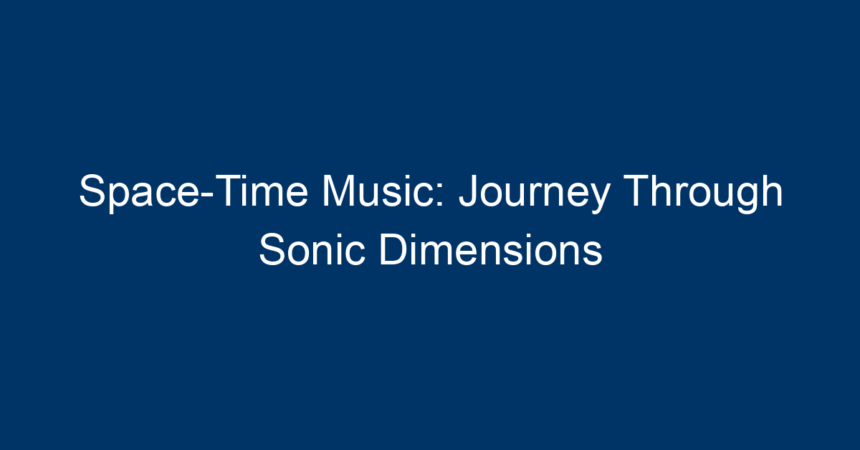Introduction
Have you ever felt that music possesses a transcendent quality, whisking you away to another realm? This feeling is not just a poetic notion; it aligns closely with the concept of space-time music. This intriguing intersection of sound and dimension invites listeners to explore auditory landscapes that can evoke emotions, memories, and even visual imagery. As we delve deeper into the world of space-time music, we will discover its significance, its various forms, and how it can enhance the human experience.
Understanding Space-Time Music
What is Space-Time Music?
At its core, space-time music refers to compositions that manipulate the listener’s perception of time and space through sound. Unlike traditional music, which often follows a defined structure, space-time music creates an immersive experience. It allows listeners to transcend conventional time and feel as if they are floating through dimensions. This phenomenon often employs progressive music styles, ambient sounds, and experimental techniques that defy traditional musical boundaries.
The Science Behind the Sound
The concept of space-time is rooted in physics, particularly Einstein’s theories of relativity, where time and space are seen as interconnected. Similarly, space-time music explores how sound waves can travel through the "spaces" of a listener’s mind and the "time" of their emotions. Through techniques like layering, modulation, and rhythmic complexity, composers craft sonic journeys that resonate deeply with our psychological states, altering how we perceive time.
The Artistic Expression of Space-Time Music
Genres of Space-Time Music
Several musical genres incorporate the principles of space-time music:
-
Ambient Music: This genre emphasizes mood and atmosphere over traditional musical structure. Artists like Brian Eno have pioneered this style, creating soundscapes that evoke feelings of space and serenity.
-
Progressive Rock: Bands such as Pink Floyd and Yes often create long, complex pieces that transport listeners through various sonic dimensions. Their use of extended compositions and thematic storytelling engages the audience in a unique auditory experience.
-
Electronic Music: With advancements in technology, electronic music has pushed the boundaries of space-time sound. Artists like Aphex Twin and Max Richter use synthesizers to manipulate sound, crafting intricate layers that create a sense of depth.
- Experimental Music: This genre encompasses a wide range of techniques and styles, often blurring the lines between music and sound art. Composers like John Cage and Karlheinz Stockhausen explore unconventional methods to challenge perceptions of time and space.
Notable Artists in Space-Time Music
Several artists stand out for their contributions to space-time music.
-
Brian Eno: Often referred to as the father of ambient music, Eno’s works invite listeners to experience sound as a tapestry of textures rather than melodies. His album "Music for Airports" is a classic example of this genre.
-
Max Richter: Blending classical with electronic elements, Richter’s compositions transport listeners through emotional landscapes. His work, such as "Sleep," combines minimalist piano with long, flowing soundscapes.
- Pink Floyd: This iconic band is renowned for their progressive rock masterpieces. Their album "The Dark Side of the Moon" is not only musically groundbreaking but also an auditory journey through space and time.
The Psychological Impact of Space-Time Music
Sound and Emotion
Research has shown that music can significantly impact our emotions and mental states. Space-time music, with its expansive narratives and immersive qualities, can evoke complex feelings. This genre serves as a powerful tool for emotional exploration, helping individuals connect with their internal worlds.
Therapeutic Uses
The therapeutic applications of space-time music are profound. Music therapists often employ ambient and experimental sounds to create healing environments that foster relaxation and mental clarity. Studies suggest that listening to space-time music can help reduce anxiety, enhance focus, and even improve sleep quality.
-
Meditation: Many practitioners use space-time music during meditation sessions to deepen their experience. The soothing sounds allow participants to escape their mental chatter, promoting greater mindfulness.
-
Stress Relief: In stressful environments, soothing ambient music can provide a refuge, allowing listeners to decompress and find tranquility.
- Creative Inspiration: Many artists and creatives turn to space-time music to fuel their imaginative processes. The unique soundscapes can stimulate new ideas and insights.
Experiencing Space-Time Music
How to Get Started
For those interested in exploring space-time music, here are some actionable steps to immerse yourself:
-
Create a Sonic Environment: Find a comfortable space where you can listen without distractions. Dim the lights, close your eyes, and allow yourself to be enveloped by the sounds.
-
Curate a Playlist: Begin by curating a playlist of space-time music. Include artists and genres that resonate with you, focusing on ambient, electronic, and experimental pieces.
-
Practice Active Listening: Instead of passively listening, engage with the music. Pay attention to the layers of sound, the shifts in tempo, and the emotional responses they evoke.
- Explore Live Performances: Attend live performances or festivals that focus on ambient and experimental genres. The communal experience can deepen your appreciation for space-time music.
Suggested Albums and Tracks
To get started, here are some recommended albums and tracks that exemplify space-time music:
- Brian Eno – "Ambient 1: Music for Airports"
- Max Richter – "Sleep"
- Aphex Twin – "Selected Ambient Works 85-92"
- Pink Floyd – "The Dark Side of the Moon"
- Tangerine Dream – "Phaedra"
Conclusion: Elevate Your Sonic Journey
Space-time music offers an unparalleled journey through sonic dimensions, giving listeners the opportunity to escape their surroundings and engage with their emotions deeply. By embracing this genre, you can not only enhance your auditory experience but also enrich your life in various ways. Whether for relaxation, meditation, or creativity, space-time music holds the key to unlocking new dimensions of experience.
So why not take some time today to immerse yourself in this captivating genre? Create your sonic environment, explore new artists, and allow yourself to journey through the compelling realms of space-time music. You may find that the expanses of sound can transform your perspective, unlocking a world of endless possibilities. Happy listening!




